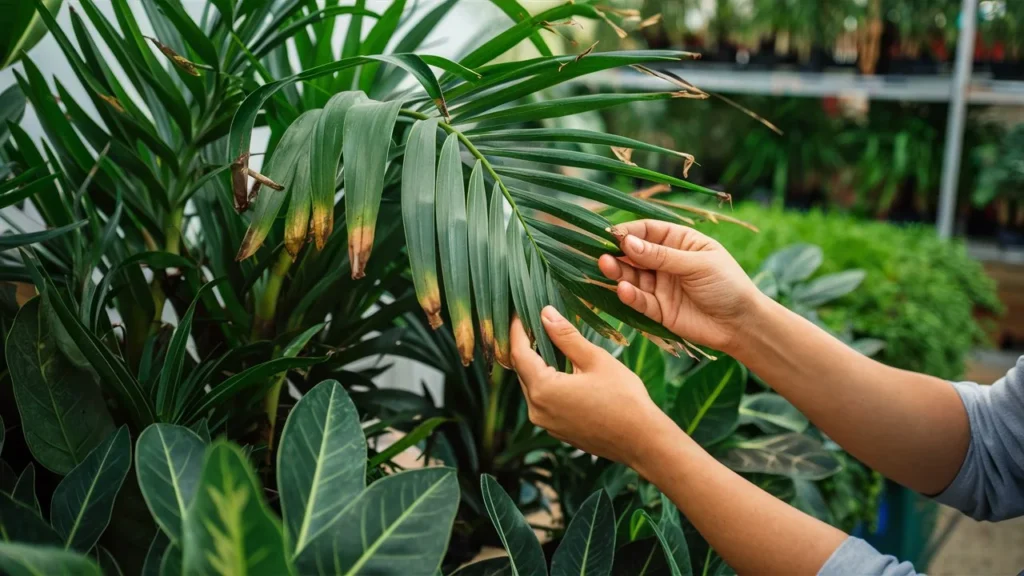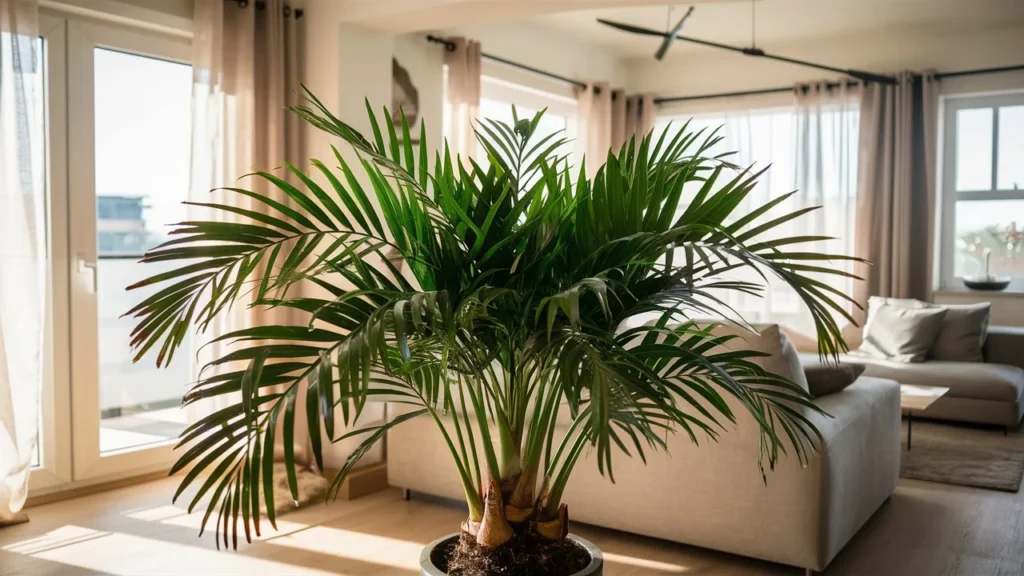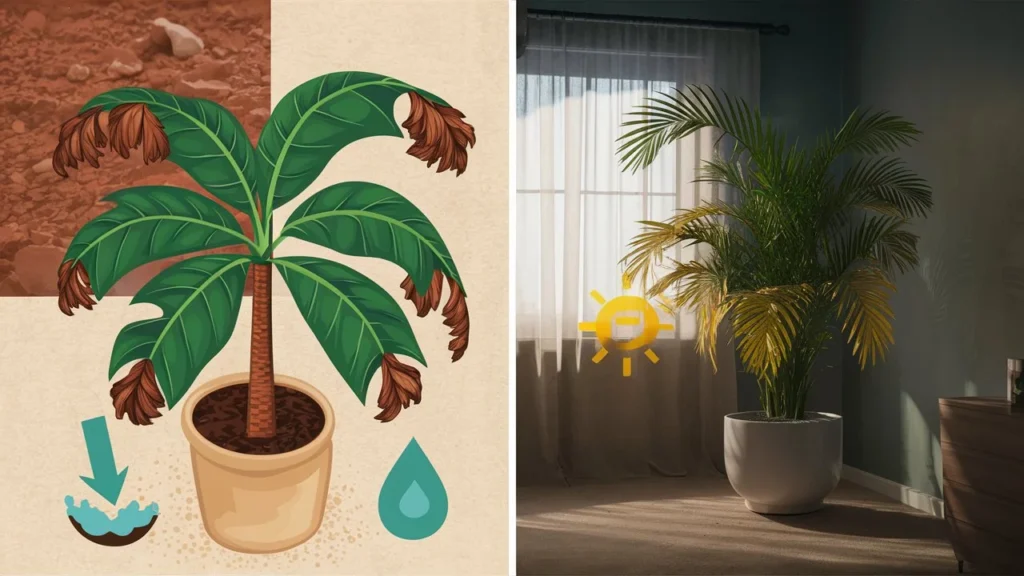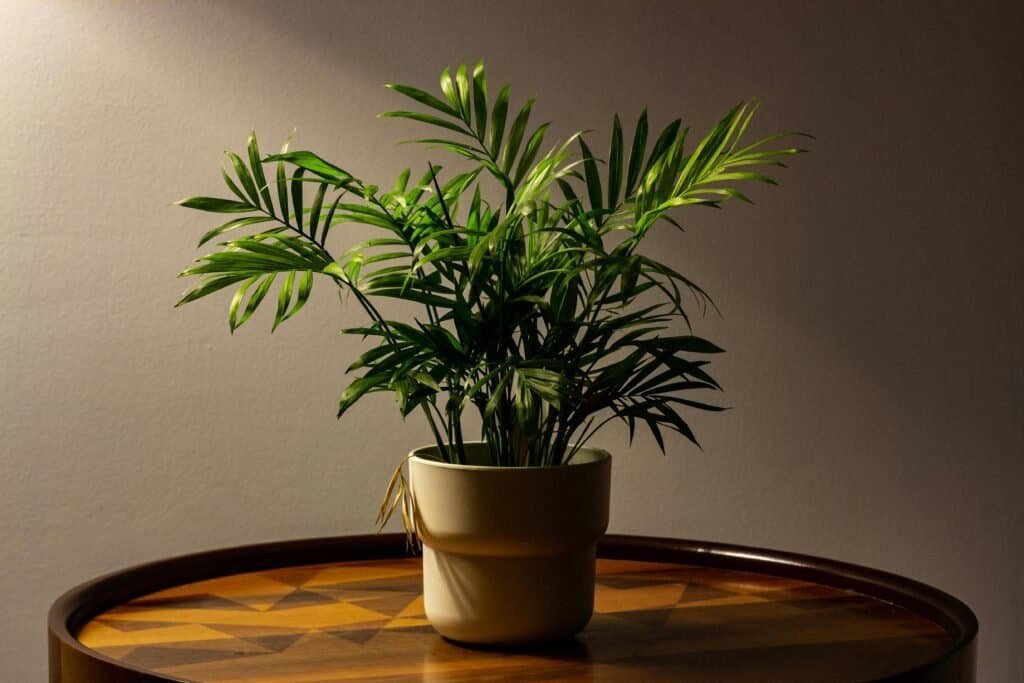Areca Palm Care Guide – How to Pick, Place, and Parent Your New Plant
Eureka palms are probably the most common palm plants you can buy for your home. They are relatively easy to care for and very popular.
It doesn’t really require much attention. It can tolerate most light levels. Watering is pretty straightforward.
If you just get your placement and your watering right, then you can have a beautiful palm that’s either small or big in your home for years to come.
So, by the end of this article, you’re gonna know exactly where to place your plant to make sure it’s super happy, what to look out for when you buy your plant to make sure you’re getting a healthy one, how to take care of your plant to make sure you know taking care of it correctly, and then anything to look out for which may be red flags and cause for you know proactive action.
Table of Contents
Choosing the Right Areca Palm
Inspecting the Leaves
The first thing to look out for when you’re buying your plants is taking a close look at the leaves.
- Healthy Leaves: Fully green from base to tip.
- Common Issue: Tips start to go black or dark brown due to overwatering.
So, if you have a super healthy plant, you will notice that it is fully green until the tips of the leaves. Where you go into issues, the most common problem you might find is when the tips start to go black or dark brown. If this tip begins to go dark brown, it’s been overwatered throughout the care and life of the plant.

Assessing Overall Health
There may have been issues, but when you’re buying it, if it looks nice and green, the stalks are standing up straight, and the plant is very happy, you
can feel comfortable taking it home.
Pro Tip: Always check the soil moisture and root condition before buying a plant. A quick check can save you from future problems.
Ideal Location in Your Home

Initial Placement by a Window
To make it as happy as possible, put it by a window, especially when you bring it home initially, and give it the largest view of the sky.
Once you do that, just keep your eye on it because the only thing that can go wrong is if it gets too much direct sunlight. If this plant gets too much direct sunlight, the tips of the leaves will start to go light brown. They will feel crispy rather than dark brown and mushy.
Adjusting Light Exposure
Suppose it starts to look crispy at the tips of the leaves. In that case, it means it’s getting too much direct sunlight. Either your watering is not done correctly, i.e., there’s not enough water in the soil, we’ll get to that in a second, or it means that you would need to move further away because that water is not traveling fast enough up the plant to hydrate the tips of the leaves. So, when you get the plant, it’s better to keep it by a window and look at it every day. The tips of the leaves, if they have already dried out, will dry out literally within a day and very slowly.
Fine-Tuning Placement
You keep an eye on the tips. If they look fine, you’re good. If it doesn’t, be vigilant.
Start moving it a little bit further back. Please don’t take it inside your room. Half a meter will make a massive difference.
That’s probably all you need to do. Once it’s been acclimated to your room or wherever you decide to place it, give it about a month, and then after about a month, you can start taking it a little bit further into the room. You should still always give it a view of the sky.
I always like to say that if it’s happy where you’ve placed it, don’t move it. This Eureka palm will not get up and walk around in the wild. So, in your house, it probably is not wise to make it do that.
How To Take Care Of This Plant
How to Water
You’ve taken it home, you’ve placed it in the perfect spot, and it looks pleased. How do you then water it to ensure it’s being watered correctly? You need to know that this plant falls into the category of plants that like its soil to dry out a little bit, which means you want about 30 to 50 percent of the top layer of the soil to dry out before you re-water it. If you further want to know about how to water your houseplants, I have a full article on it. Click Here>>
Watering Issues
The three most common things you might see happening with this plant relate to the tips.
Overwatering Signs
- Dark Brown/Black Tips: Indicates overwatering and root rot.
Underwatering Signs
- Dry and Crispy Tips: Result of underwatering.
Solution to This Problem
- Snip Off Affected Tips: They won’t return to green.
- Adjust Watering Frequency: Based on your plant’s needs.

Overwatering Signs
If the tips of the leaves look dark brown, almost blackish, it means that they’ve been overwatered. Basically, what’s happening is that they’re being overwatered, and the roots are rotting. That rot is being pulled up the plant through the roots up the stem and pushed towards the ends of the leaves. Now, it’s important to notice that these are dark brown in nature, especially when they first appear; they won’t feel dry and crispy.
Underwatering Signs
Dry and crispy are the second issue on the tips, which results from underwatering. The tips of the leaves are getting dry, i.e., water evaporates faster than the plant can get water to that bring, and as a result, it’s drying out and turning light brown. You will likely know if something is wrong with the tip, and you will probably have an excellent intuitive understanding of whether I am overwatering it or underwatering it.
If it’s right by the window, it’s getting lots of direct light, and you haven’t watered it in a few weeks, you will notice the tips being dry. It’s going to let you know. Similarly, if you feel like the soil has been continuously moist every time you check it or water it and you see it go dark brown, you probably will know that you’ve underwatered your plant.
The solution to This Problem
In either case, what you want to do is, first of all, address the tip. You have to snip it off. It won’t return to green, but that’s fine. Cut off those tips.
Please ensure they’re clean, and you clean them and transfer bacteria or pathogens onto the plant you don’t want there. Once that’s done, you need to address the root cause of what happened. Again, try to understand from your practice whether your plant was overwatered or underwater, and then, obviously, if it was overwatered, wait longer between watering cycles.
If you feel you may have underwatered it, increase your watering cycle frequency. Now, notice I’ve said to increase or decrease the frequency. It’s not about the amount you’re giving it; it’s about the waiting periods between when you’re giving it.
Root Problems
Identifying Root Issues
Sometimes what may happen is you may see an Eureka palm frond fall off.
- Root Anchorage: Each stem has roots holding onto the soil.
- Overwatered Roots: Lead to root rot and stem falling.
If you take that front and then pull it out, it’s easy. If I try to pull, like literally, if I hold two, I can pull out the whole root, right? With those, if you pull one, it’ll just come out of the pot. To understand what happened, you need to know what’s going on beneath the surface layer of the soil, and what’s happening is each of these stems has roots coming out of it and holding onto the soil.
That root provides anchorage for the entire stem. When you overwater a particular area of that plant, those roots end up dying and rotting away. That stem ends up falling, which is why you cannot pull it out entirely.
Addressing Root Rot
If that happens, you can throw away that stem, but you must step back and understand what went wrong. If that went wrong, you were likely overwatering it, and then you need to take steps to address your overwatering to reduce the frequency of your watering so it doesn’t happen again.
Promoting New Growth
Unfortunately, if you see it fall down, it’s not going to recover. The best thing to do is snip it off and throw it away, and hopefully, you will get new stems. What I’ve seen other people do is tie it together and try to force it to stay up.
It will never go back up entirely, so tying it is not doing much for me. Just throw it off entirely. New stems will grow as long as you give them all the care and love they have, which I know you will do because you are an awesome plant parent, and this will be your favorite child.







 *(Include an image of droopy leaves)* Some plants, such as calatheas, prefer moist soil at all times; otherwise, they develop that signature brown tissue damage on the leaves. The annoying thing here is that the damage cannot be reversed and can only be cut away, leaving you with a damaged plant. If the soil of your plant is bone dry, you'll notice that it's pulling away from the sides of the pot. This is because the soil has shrunk due to a lack of moisture, so make sure you are not letting this happen by watering a little more frequently. #### Signs Your Plant is Overwatered (darkgreen) Overwatering plants is a really common way that people kill their plants. Beginner plant enthusiasts often have a common misconception that houseplants need lots of water, but the reality is that these plants are native to hot climates where they may get periods of drought followed by large rain which rehydrates them. **Yellowing leaves** (red) can indicate an overwatering problem as well as an underwatering problem. If you are watering your plant too often and the soil is always wet, this can lead to root rot, which will begin to affect the leaves of your plant. **Limp and mushy leaves** (red) also indicate that you are overwatering your plant. This is particularly true with succulents such as Echeverias. Echeverias store water in their thick leaves and have difficulty storing excess water if you are watering your plant too often. This leads to mushy plants that eventually fall off.  *(Include an image of yellowing leaves)* Philodendron and Pothos plants tend to get mushy leaves that fall off if the soil is consistently soggy. My Philodendron Birkin recently developed some new brown leaves that fell off because I was overwatering it. Whereas crispy brown edges on leaves indicate an underwatering problem, if the whole leaves are turning brown, this tends to mean that the plant tissue is rotting due to too much water. You may also notice some water droplets on the ends of the leaves of some of your plants. This is the plant perspiring excess water through its leaves and can indicate that you are giving the plant too much water. Now, this tends to happen on plants that prefer drier soil, and I notice it quite often on my Philodendron Birkin and my Tradescantia Nanook. **Increased presence of fungus gnats** (red) can also be a sign that your plant is too moist. Fungus gnats like a moist top two inches of soil to breed and lay their eggs, so if your soil is wet, it creates a breeding ground for gnats. If you see lots of flea-like flies jumping around the top of your soil, I would just dial back on the watering and let the top two inches of the soil dry out before watering again. #### Watering Tips (darkgreen) It is important to allow the soil of your houseplant to dry out between waterings. This prevents the possibility of over-watering, which is one of the most common reasons people kill their plants. **Check the soil moisture** (red) before watering your plant by sticking your finger two inches into the soil. If it feels wet, leave it a few days and then check again. An even better way to check the soil moisture is to invest in a moisture meter. This device needs no batteries and tells you exactly how much moisture is in the soil, giving you control over watering your plants.  *(Include an image of a moisture meter)* When you identify that your plant needs water, make sure you give it a thorough soaking. Take your plant to a sink area and soak the soil four or five times until water drains out of the bottom each time. This ensures that all the soil in the pot gets moistened and there are no dry patches. **Bottom watering** (teal) is a method that has changed the health of my plants since I implemented it a couple of years ago. Place your plant in a container of water and let it absorb moisture from the bottom up. This method prevents water from getting on the leaves, which can cause leaf tissue damage. I hope this article was helpful. Now you know when to water your plants and when not to. Apply this knowledge to your plants and see the growth. Happy gardening! --- Incorporating these visual and formatting enhancements will make your article more attractive and engaging for your readers.](https://growinggaze.com/wp-content/uploads/2024/05/pexels-artempodrez-7242495-scaled.jpg)

